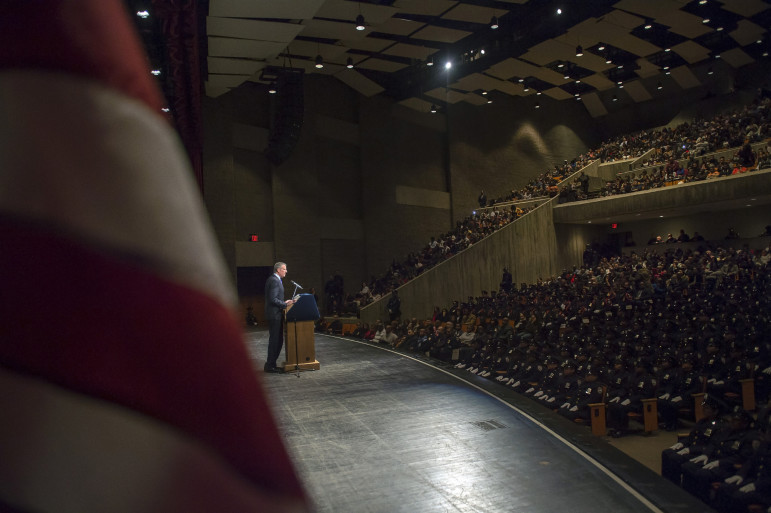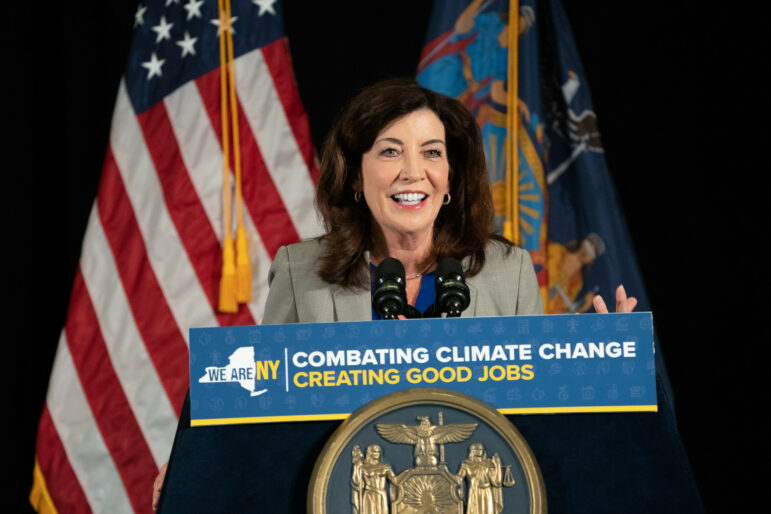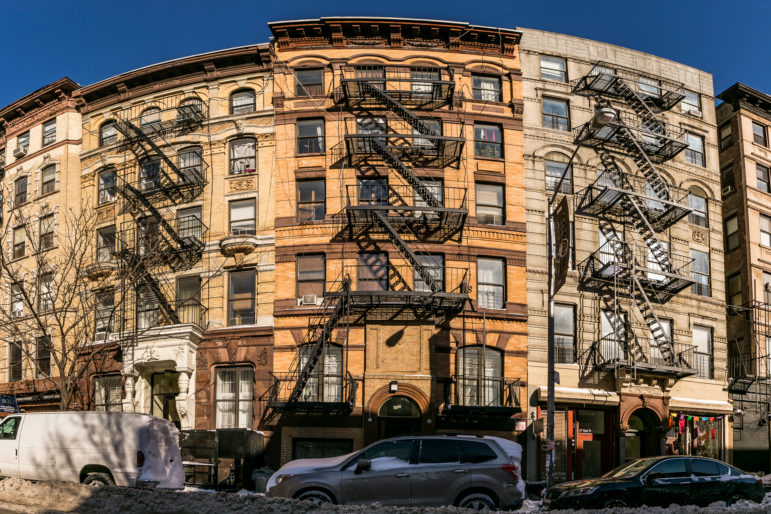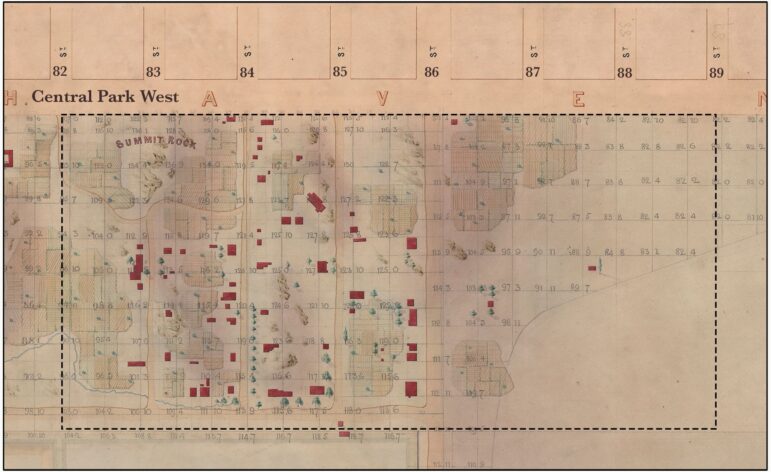
Ed Reed/Mayoral Photography Office.
Mayor de Blasio at a Department of Correction graduation ceremony earlier this month.
On Thursday morning Mayor Bill de Blasio reassured a room full of business leaders that he’d never let the city go back to “the bad old days” as he thanked them for helping creating jobs in the city. In a seeming acceptance of conservative tabloid talking points that for most of his time in office have warned of the city’s slide into decay, the mayor appeared to defer to his critics on the right. Late yesterday afternoon, however, there were over a hundred protesters, organized by tenants groups from Chinatown and the Lower East Side, who demonstrated outside his Gracie Mansion home in opposition to de Blasio’s so-called affordable housing plan–which one speaker decried as a “luxury housing plan.”
What kind of mayor do we have in City Hall right now?
Take homelessness, a rallying cry for pearl-clutching doomsayers, and public housing, a constant talking point for advocates of more policing: In spite of last month’s announcement of a plan to provide supportive housing for some homeless and vulnerable New Yorkers, the mayor leaned heavily on the NYPD to address homeless people. On 125th and Lexington, where many homeless congregate, a mobile command center has been parked for almost two months while cops strive to keep people from sitting. In NYCHA, de Blasio continues to take steps down the ‘tough on crime’ road opened up after the death of police officer Randolph Holder. Responding to Holder’s death by criticizing the criminal justice system as one that was too lenient, the mayor has signaled a push for NYCHA, the agency that oversees public housing in the city, to more efficiently get ‘criminals’ out of its buildings. Now NYCHA head Shola Olatoye is saying that the city will bring back it’s ‘not wanted’ list of tenants who have committed crimes.
A police-happy, law and order progressive? For over two years de Blasio has insisted that his support for an ‘evolving’ Broken Windows–one that posits a link between enforcement of quality of life infractions and serious index crimes–is in line with his progressivism. This despite the ideological connection of the theory to those on the law and order right: Rudy Giuliani, the Manhattan Institute, etc.
Isn’t this all contradictory? De Blasio proudly plants one foot in what we are told is a progressive agenda, with another knee-deep in Giuliani-ism. Some homeless New Yorkers may not trust city hall to help house them when they have also been trying to arrest them. Similar cynicism among NYCHA residents might arise if there are no clear answers as to who will be the targets of a new public housing squeeze. Will the city go after violent criminals or low-level offenders? Will residents and families targeted for eviction be people merely charged with crimes–or actually convicted of them? If a young person is arrested and banned from public housing, how will this impact the rest of the family? The city doesn’t offer answers as to what might be the long term effect of plan that see authorities posting lists of undesirables.
Additionally, de Blasio’s attempts to lease NYCHA property to private developers, a variation of Bloomberg idea, feeds a growing sense among some that the mayor, in collusion with big real estate, wants to eventually privatize the city’s last real affordable housing stock: public housing. Mix a police department, again the focus of intense criticism distrust, with rumors of evictions and alarm bells go off. In a city that has become impossibly expensive, where does one go? If a growing police department seems beyond reform, to whom does one turn? Candidate de Blasio spoke to both of these issues during a campaign that sought to tap into citizen’s frustrations that there were two cities in New York, not one.
His first two years in office, however, continue to raise questions–but perhaps he had already answered them in not so many words. By bringing back NYPD commissioner Bill Bratton, Giuliani’s top cop, de Blasio signaled from day one that any changes to police work would be made in safe moderation. Reassuring developers who relish a sanitized, business-nurturing climate for a gentrifying city, de Blasio has in fact relied on real estate money for what he says are progressive aims. A man once accused of being a socialist is now enlisting the city’s super-rich to help combat inequality. While he extends olive branches to and receives donations from a wealthy donor class, his base support, even among allies, wanes.
The development dollars that funded de Blasio’s campaign and fill his political coffers today are comforted by the presence of someone like Bratton. There is, in my opinion, a connection: arrests, fines, court appearances and bail money squeeze over-policed communities through one side; the ever-rising rents and cost of living on the other. More importantly for developers, the bait for nouveau residents looking to plant their flags in communities of color primed for a rezoning, like Spanish Harlem or East New York, is the promise of a safe walk to the subway, undisturbed by the beggar or the young black man, both of who’re now either safely behind bars or out of the neighborhood altogether.
The mayor is making clear who he is. It’s about time we all just accepted it.









3 thoughts on “Op-Ed: Beaten Back By Conservative Critics, is De Blasio now Joining Them?”
Not just the mayor, as the Speaker and the entire City Council seem to have followed suit.
The mayor’s rezoning proposal is a red herring. By increasing the height limit, developers can add more units at market rate. The mandate that a percentage of these units must be set aside for low-income is a drop compared to the number of overall units at market price. The mayor is wrapping a poison pill in bacon. It looks good on paper but in the long-term it will wind up killing the working class of this city. Mayor de Blasio is a fraud. He duped the entire city into thinking that he is a defender of the working class but in reality he kowtows to the real estate lobby. He sucks.
IIRC the increased height limit was supposed to encourage more ground-floor retail. It is muddled and unclear if it’s to apply to the entire city or just those areas zoned for apartment buildings, R6 to R10 only.